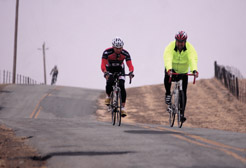
Ride in SBC draws another 490 participants for second annual
event
Cyclists sailed through San Benito County over the weekend for
the second annual Condor Classic bicycle ride. The event drew 490
participants, some from San Benito and the greater Bay Area, and
others from places as far-flung as Missouri and Texas.
Ride in SBC draws another 490 participants for second annual event
Cyclists sailed through San Benito County over the weekend for the second annual Condor Classic bicycle ride. The event drew 490 participants, some from San Benito and the greater Bay Area, and others from places as far-flung as Missouri and Texas.
“We marketed to all the riders we had last year, and actually learned through that effort that we probably had 70 percent new riders,” said Kathy Schipper, the chairwoman of the event. “We had some repeats and we had twice as many volunteers.”
More than 115 volunteers helped coordinate the event, from committee chairs to those manning rest stops during the event.
Sheila Dundon, of Priority Leadership Group, served as the volunteer coordinator this year. She said she tried to recruit people who had an interest in some aspect of the event, whether it be cycling, condors or Pinnacles National Monument.
“We need people who are willing to do whatever it takes on that day [of the event] and we had a fantastic group of individuals who would do whatever they were asked,” Dundon said. “You can plan until you are green in the face, but on that day, you have to be ready to do anything and everything, and be able to anticipate needs.”
Some of the volunteers worked as many as 14 hours during the Oct. 10 ride, but many started volunteering months in advance.
The group created rack cards about the event that were put out around the county, but they also used e-mail blasts to past participants and sent rack cards to bicycle shops throughout California.
Schipper and her husband attended some of the bigger bicycle events in California, such as the AIDS ride from San Francisco to Los Angeles (which their son participated in) and handed out cards there. She said she and some of the other volunteers even took rack cards with them when they went on vacation.
Schipper said the inaugural event in 2008 allowed them to work out many of the kinks in the planning process, such as estimating how much coffee is needed for the morning registration.
The one minor snag this year was that some of the riders beat volunteers to the first rest stops.
“Some of the riders were just so fast,” Schipper said. “To the rider, they are not there to stop and eat and chat, in that sense.”
Still, because the recent event launched from a different starting point, many of the logistics had to be redesigned, she said.
“We tried to reverse it, in a way so riders did not have as much of a headwind on the way home,” she said.
The event was staged at the Windhaven Ranch, with five routes from which to chose, including a family friendly 10-mile ride, a 20-mile ride through the San Juan Valley, a 40-mile trek to Aromas, a 100-kilometer trek through the county and the 100-mile Centennial challenge route that took riders to Pinnacles National Monument and back.
Mark Paxton, who helped design the routes, said they were based on the start of the event at the ranch, near San Juan. Some of the routes were also redesigned so they did not conflict with other traffic.
“We put people in different places – through downtown San Juan Bautista,” he said. “Some took a new direction out to Anzar Hills, and people liked that.”
The routes kept riders off the major highways in the region.
“People reacted favorably,” he said. “Registration was in a big, red barn. The post-ride meal was outdoors. People could eat at tables with tablecloths under the valley oak trees, or they could spread out a picnic blanket and eat on the lawn in a cherry orchard.”
Nants and Tim Foley, of San Benito Bounty, worked with local growers and food producers to incorporate as much local food into the lunch and the rest stops as possible.
“Riders themselves are recognizing how the apples they had at one pit stop came out of an orchard they rode by,” Schipper said. “The salad they had for lunch was grown locally. They are beginning to connect that everything was so fresh and so local, and that is a big part of their experience.”
She noted that some of the rest stops had dried apricots from B&R Farms, Guerra walnuts and cherry tomatoes from Swank Farms.
Though the event is just a week past, Schipper and some of the committee members are already looking toward the 2010 event.
“There have been some wonderful suggestions made about partnering with sponsors with the pit stops and kind of doing more outreach to other volunteer groups and nonprofits,” she said.
For the first two years, the money raised at the San Benito County Chamber of Commerce sponsored event went to Pinnacles Partnership, a nonprofit that promotes activities at Pinnacles National Monument such as condor recovery efforts and science camps.
The second focus for next year will be on growing the number of participants.
“We were worried about the economy affecting ridership or sponsorship, but we still had a wonderful list [of sponsors] and it didn’t affect our numbers,” Schipper said. “We just have a more and more original vision for the ride that is being realized.”
Though it sounds daunting, she said she would like to see the race grow to as many as 2,000 riders in the years to come.
“The real purpose of the ride is not just the numbers, but the experience and how the riders get a hold of what is going on in this county,” she said.
As for next year’s routes, Paxton said: “It will depend on feedback and also where we stage the event. A new location, of course, means new routes. It’s kind of fun to show people different parts of the county.”









